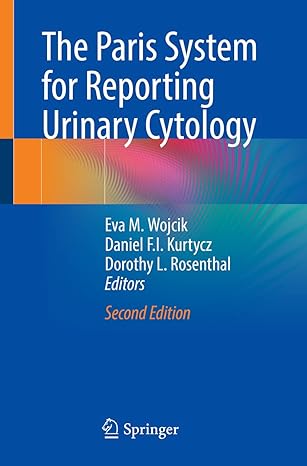<목차>
1 Pathogenesis of Urothelial Carcinoma / 1
2 Adequacy of Urine Specimens (Adequacy) / 7
3 Negative for High-Grade Urothelial Carcinoma (NHGUC) / 21
4 Atypical Urothelial Cells (AUC) / 63
5 Suspicious for High-Grade Urothelial Carcinoma (SHGUC) / 85
6 High-Grade Urothelial Carcinoma (HGUC) / 97
7 Cytopathology of the Upper Urinary Tract / 115
8 Non-Urothelial Malignancies and Other Miscellaneous Lesions / 143
9 Ancillary Studies in Urinary Cytology / 193
10 Cytopreparatory Techniques / 221
11 Risk of High-Grade Malignancy (ROHM) / 249
12 Clinical Management / 257
13 The History of Urinary Cytology: The Long and Winding Road to Paris 2.0 / 267
The first edition of The Paris System for Reporting Urinary Cytology introduced a completely new paradigm
for detecting bladder cancer by urine cytology. This system concentrated on defining morphological
characteristics of the most clinically significant form of bladder cancer, High Grade Urothelial Carcinoma.
This new approach has been widely accepted throughout the world, and has become part of the daily practice
of cytology. Considering that the first edition of The Paris System (TPS) introduced a new model of urinary
cytodiagnosis, verification and expansion of initial material and data were anticipated. Based on evolving
knowledge and readership requests, the group of highly experienced authors have created a new edition of
TPS. This second edition includes areas and issues not originally covered. A new chapter on urine cytology
of the upper tract, a rarely addressed topic, has been introduced. Furthermore, the issue of cellular
degeneration is discussed in the criteria of all diagnostic categories. Examples of standardized reports
are included in each chapter. Most importantly, a separate chapter presents data defining the risk of
malignancy (ROM) for each diagnostic category to inform clinical management. New high quality images
augment those of the first edition to better illustrate diagnostic clues and potential pitfalls. In
addition to chapters on diagnostic criteria, current concepts of pathogenesis of bladder cancer, specimen
adequacy and preparation, and ancillary tests are covered in separate chapters. A bonus to the volume is a
comprehensive history of urine as the earliest diagnostic sample of human disease, richly illustrated with
artworks from major museums.
Written by internationally recognized authorities, this comprehensive and evidence-based guide to urine
cytology is supported by the newest data confirming the original concept and significance of diagnostic
criteria defining High Grade UrothelialCarcinoma. TPS is an essential tool for anyone who is practicing
urinary cytology, including cytotechnologists, pathologists-in-training and practicing pathologists. This
book should find a place in every cytology laboratory throughout the world.
The Concept has been endorsed by the American Society of Cytopathology, and the International Academy of
Cytology.


